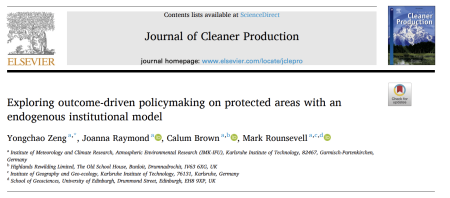
Resource description:
Covering over 16 % of the global land surface, nearly 300,000 Protected Areas (PAs) play a pivotal role in conservation efforts worldwide. The allocation and management of these areas vary widely, reflecting the dynamism and complexity of the land use system. Understanding the impacts of PA-related policy mixes on ecosystem service outcomes and the wider land system is essential but challenging. In this research, we employ an endogenous institutional model coupled with an agent-based land use model to examine the processes and feedbacks from PA implementation and land system changes under multiple policies. We focus on modelled PA policy targets that aim to reach conservation outcomes by increasing a proxy for habitat diversity. Alongside other policies with different targets in the land system, PA policies generate dynamic patterns that are challenging to discern through an exogenous, non-systemic lens. Findings reveal that 1) Neither subsidies nor PAs in isolation effectively enhance habitat diversity in the model; however, their synergic implementation effectively increases it. 2) Increasing PA extent to 30 % of the land area does not harm modelled agricultural output in the long term, due to the land system's resilience and adaptability in providing ecosystem services. 3) When the geographic extent of PAs is predetermined, radical expansion proves more beneficial than gradual expansion, as the latter causes prolonged disruptions to existing land uses while accruing fewer cumulative sustainability benefits over time. These insights highlight the importance of a systemic, integrated approach to PA management for sustainable conservation outcomes.
Highlights
•Using an endogenous institutional model with a land use model to explore policy dynamics.
•Subsidies or PAs alone do not improve habitat diversity, but combining them does.
•PAs do not necessarily harm agricultural production, due to land system resilience.
•PA's radical expansion disrupts land use less often than gradual expansion.
•A systemic and integrated approach to PA policymaking and management is necessary.
Author/Contact:
Yongchao Zeng, Joanna Raymond, Calum Brown, Mark Rounsevell